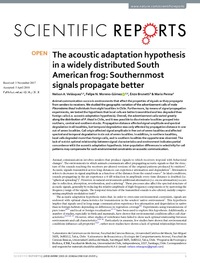Mostrar el registro sencillo de la publicación
The acoustic adaptation hypothesis in a widely distributed South American frog: Southernmost signals propagate better
| dc.contributor.author | Velásquez-Soto, Nelson | |
| dc.contributor.author | Moreno-Gómez, Felipe N. | |
| dc.contributor.author | Brunetti, Enzo | |
| dc.contributor.author | Penna, Mario | |
| dc.date.accessioned | 2018-06-06T13:59:21Z | |
| dc.date.available | 2018-06-06T13:59:21Z | |
| dc.date.issued | 2018 | |
| dc.identifier.uri | http://repositorio.ucm.cl/handle/ucm/1796 | |
| dc.description.abstract | Animal communication occurs in environments that affect the properties of signals as they propagate from senders to receivers. We studied the geographic variation of the advertisement calls of male Pleurodema thaul individuals from eight localities in Chile. Furthermore, by means of signal propagation experiments, we tested the hypothesis that local calls are better transmitted and less degraded than foreign calls (i.e. acoustic adaptation hypothesis). Overall, the advertisement calls varied greatly along the distribution of P. thaul in Chile, and it was possible to discriminate localities grouped into northern, central and southern stocks. Propagation distance affected signal amplitude and spectral degradation in all localities, but temporal degradation was only affected by propagation distance in one out of seven localities. Call origin affected signal amplitude in five out of seven localities and affected spectral and temporal degradation in six out of seven localities. In addition, in northern localities, local calls degraded more than foreign calls, and in southern localities the opposite was observed. The lack of a strict optimal relationship between signal characteristics and environment indicates partial concordance with the acoustic adaptation hypothesis. Inter-population differences in selectivity for call patterns may compensate for such environmental constraints on acoustic communication. | es_CL |
| dc.language.iso | en | es_CL |
| dc.rights | Atribución-NoComercial-SinDerivadas 3.0 Chile | * |
| dc.rights.uri | http://creativecommons.org/licenses/by-nc-nd/3.0/cl/ | * |
| dc.source | Scientific Reports, 8, 6990 | es_CL |
| dc.title | The acoustic adaptation hypothesis in a widely distributed South American frog: Southernmost signals propagate better | es_CL |
| dc.type | Article | es_CL |
| dc.ucm.facultad | Facultad de Ciencias Básicas | es_CL |
| dc.ucm.indexacion | Scopus | es_CL |
| dc.ucm.indexacion | Isi | es_CL |
| dc.ucm.doi | doi.org/10.1038/s41598-018-25359-y | es_CL |



